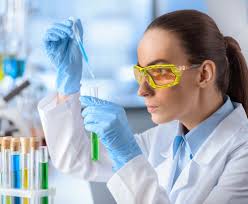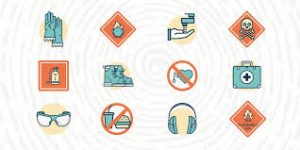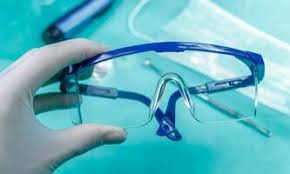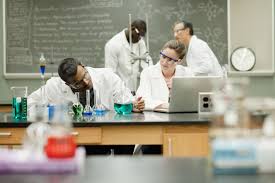In the world of scientific exploration and experimentation, the lab serves as a hub of innovation and discovery. Yet, amidst the excitement and pursuit of knowledge, it is crucial to prioritize safety above all else. As any seasoned lab professional knows, protective measures, such as wearing goggles, are indispensable safeguards against potential hazards. These protective eyewear not only shield the eyes from harmful substances, chemicals, and projectiles but also serve as a visual reminder of our commitment to maintaining a secure work environment.

In this blog post, we aim to demystify the intricacies surrounding eye protection in the laboratory. We will delve into the various scenarios that necessitate the use of goggles, providing practical insights and helpful tips on staying safe during your scientific endeavors. Together, let us embrace a culture of safety and prioritize the well-being of ourselves and our fellow researchers in the pursuit of scientific excellence.
Table of Contents
- Ensuring Laboratory Safety: The Importance of Eye Protection
- Working In The Laboratory: Eye Hazard Review
- OSHA Standards For Eye And Face Protection
- Goggles as Primary Eye Lab Protectors
- How To Wear Goggles Properly
- FAQs
- Protect Your Eyes!
Ensuring Laboratory Safety: The Importance of Eye Protection
However, the question remains: When exactly should one don these essential eye protectors in the lab? The answer lies in the nature of the tasks at hand. Whether you are handling corrosive chemicals, conducting experiments involving airborne particles, or operating equipment that poses a risk of splashing or fragmentation, wearing goggles becomes an imperative. By embracing this proactive approach, we can ensure that our eyes remain shielded from potential harm.
Understanding the dos of eye protection is equally essential. Properly fitting goggles that conform to safety standards should always be chosen. It is crucial to inspect them regularly for signs of wear and tear, as compromised goggles can compromise our safety. Moreover, remember to sanitize and maintain the cleanliness of goggles, as contaminants can hinder visibility and compromise the effectiveness of the protective gear.
While the necessity of wearing goggles in the lab is undeniable, it is also important to acknowledge that each laboratory may have specific requirements based on its unique hazards. Familiarize yourself with the safety guidelines and protocols established by your institution or regulatory bodies to ensure full compliance.
Working In The Laboratory: Eye Hazard Review
To mitigate the potential harm of chemical substances on the ocular region, it is essential to don appropriate protective eyewear specifically designed to shield against these hazards. This specialized eyewear acts as a reliable barrier, preventing direct contact between harmful substances and the vulnerable eye tissues. By prioritizing the use of approved eye protection that meets recognized safety standards and offers comprehensive coverage around the eyes, laboratory workers can significantly reduce the risk of chemical-related eye injuries.
In addition to proper eyewear selection, regular inspections and maintenance of the protective gear are imperative to ensure its ongoing effectiveness. By incorporating routine checks and necessary maintenance procedures, laboratory personnel can ensure that their eye pr
 otection remains uncompromised and ready to safeguard against potential dangers.
otection remains uncompromised and ready to safeguard against potential dangers.
The laboratory environment presents various potential hazards that must be carefully considered to ensure the safety of the eyes and face. Among the hazards that pose a risk to these vital areas are:
- Chemical Exposure: Direct contact with hazardous chemicals can result in chemical burns or irritations. It is essential to identify the specific chemicals used in the laboratory and understand their potential risks to the eyes and face. Protective measures such as appropriate eyewear and face shields should be implemented to minimize the risk of chemical exposure.
- Flying Particles: Laboratories often involve activities that generate airborne particles, such as grinding, cutting, or mixing materials. These particles can cause injuries to the eyes if they come into contact. Safety glasses or goggles with side shields should be worn to provide adequate protection against flying debris.
- High-Intensity Light Sources: Intense light sources used in laboratories, such as lasers or ultraviolet (UV) lamps, can cause damage to the eyes if not properly shielded. Eye protection devices, such as specialized goggles or face shields with appropriate filters, should be used to protect against harmful light radiation.
- Biological Hazards: Laboratories dealing with biological materials, including microorganisms or viruses, must take precautions to protect the eyes and face from potential contamination. Safety goggles or face shields should be worn to prevent accidental splashes or sprays that may contain harmful biological agents.
- Thermal Hazards: Laboratory processes involving heat sources, such as open flames or hot surfaces, pose a risk of thermal injury to the eyes and face. Heat-resistant goggles or face shields should be worn to shield against potential burns or heat-related accidents.
- Corrosive Substances: Laboratories often handle corrosive chemicals that can cause severe damage to the eyes and face upon contact. These substances have the potential to corrode and burn the skin and delicate tissues. It is essential to wear appropriate protective eyewear, such as goggles or face shields, specifically designed to resist the corrosive properties of these substances.
- High Temperatures: Processes involving high temperatures, such as heating or boiling of materials, pose a risk of thermal burns to the eyes and face. It is crucial to use protective eyewear that can withstand high temperatures and provide adequate coverage to shield against heat-related injuries
Understanding and addressing these potential eye and face hazards in the laboratory environment is crucial to ensure the well-being and safety of laboratory personnel. By implementing appropriate protective measures and adhering to established safety protocols, the risk of eye and face injuries can be significantly reduced.
OSHA Standards For Eye And Face Protection
The Occupational Safety and Health Administration (OSHA) has specific regulations regarding eye and face protection in the workplace. According to OSHA general requirements, when working with hazardous materials, such as flying particles, molten metal, liquid chemicals, acids or caustic liquids, chemical gases or vapors, or potentially injurious light radiation, the employer must ensure that each affected employee uses appropriate eye or face protection. OSHA Construction Standard 1926.102(a)(1) specifies that employees shall be provided with eye and face protection equipment when machines or operations present potential eye or face injury from physical, chemical, or radiation agents. In other words, if there’s a potential for an eye or face injury, you should be wearing goggles.

Employers are also responsible for selecting the appropriate type of eye and face protection for their workers based on the hazard. For example, if you’re working with chemicals, your employer should provide you with chemical-resistant goggles to wear while working.
Finally, employers must also ensure that all eye and face protectors fit properly General requirements and Standarts.
Goggles as Primary Eye Lab Protectors
Goggles are the primary protectors intended to shield the eyes and it is important to wear goggles that fit snugly and provide a complete seal with your face. The first step to protecting your eyes is understanding Goggles are most commonly used to protect against the potential hazards that might be present in your work area, but they can also provide protection from dust, flying debris, and chemical vapors or splashes.
Next you need to choose the right type of goggles for the hazard. There are three main types of goggles:
- Splash Goggles – have indirect ventilation and seal tightly to your face to protect against liquids.
- Dust Goggles – have direct ventilation and a snug fit to keep out dust particles.
- Chemical Goggles – have indirect ventilation and are made of chemically resistant materials to protect against vapors, fumes, and splashes.
How To Wear Goggles Properly
After you’ve selected the right type of goggles, it’s important to ensure that they fit properly. Goggles should sit snugly on your face and provide a complete seal with no gaps. If you wear glasses, you may need to purchase prescription goggles or special adapters to accommodate your vision needs.
In some cases, wearing a full-face shield in addition to goggles may be necessary to provide the appropriate level of eye protection. Face shields offer additional protection from flying debris and chemical splashes, but they do not provide ventilation like goggles do. When selecting a face shield, make sure that it extends below your chin and wraps around the sides of your head for the greatest level of protection.
Remember, when working with hazardous materials, it’s always better to err on the side of caution and wear more eye protection than you think you may need. By following these simple guidelines, you can help keep your eyes safe while working in the laboratory.
Now that we’ve gone over the dos and don’ts of wearing goggles in the lab, let’s take a look at some of the most common questions people have about this important piece of personal protective equipment.
FAQs
Do I really need to wear goggles in the lab?
Yes, wearing goggles in the lab is essential for your safety. Goggles provide crucial eye protection against various hazards, including chemical splashes, flying debris, and other potential sources of eye injury. Even a brief moment of exposure to hazardous substances or particles can have severe consequences for your vision. Therefore, it is highly recommended and often required to wear goggles at all times when working in the lab to minimize the risk of eye-related accidents and ensure the well-being of your eyes.
Are prescription eyeglasses sufficient for eye protection in the laboratory?
Prescription eyeglasses alone are not sufficient for adequate eye protection in the laboratory. While they may provide some level of protection against airborne particles or minor impacts, they do not offer the same level of coverage and protection as dedicated safety eyewear. Prescription safety glasses, on the other hand, are specifically designed to meet safety standards and provide both vision correction and protective features. It is important to consult with an eye care professional to ensure the appropriate prescription safety eyewear is selected for laboratory work.
Can contact lenses be worn as eye protection in the laboratory?
No, contact lenses alone do not provide sufficient eye protection in the laboratory. While contact lenses may correct vision, they do not offer physical protection against chemical splashes, flying debris, or other hazards that can cause eye injuries.
Can I wear contact lenses if I’m wearing goggles??
It’s generally not recommended to wear contact lenses while working with hazardous materials, as they can trap contaminants against your eye and increase the risk of an eye injury. If you must wear contact lenses, be sure to select a pair of goggles that fit snugly against your face to help prevent any chemicals from getting behind the lens.
What happens if I get chemical splash in my eye while wearing goggles?
If you do happen to get a chemical splash in your eye while wearing goggles, it’s important to flush out your eye immediately with clean water for at least 15 minutes. You should then remove your goggles and any other contaminated clothing and seek medical attention as soon as possible.
Protect Your Eyes!
Wearing the proper eye protection is an important part of working safely in the laboratory. By following these dos and don’ts, you can help ensure that your eyes are protected from potential hazards.
Do you have any questions about wearing goggles in the lab? Let us know in the comments below!
